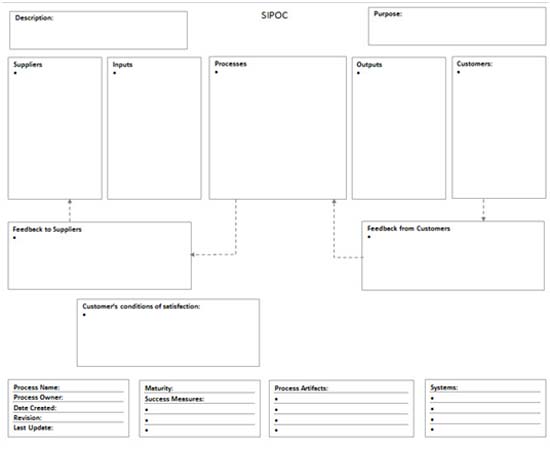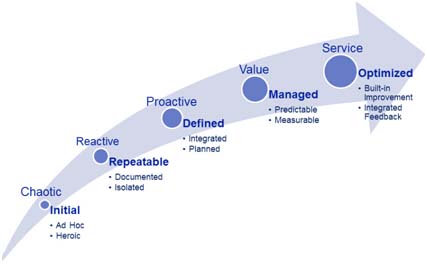Recap
My first two features described how I use SIPOC (Supplier, Input, Process, Output, Customer) diagrams to capture some essential characteristics of major business functions.
In the first, I walked you through the benefits of using a SIPOC instead of more detailed swim lane diagrams. These include naming your customer, focusing on the value being adding and not just the tasks being performed, and naming a Process Owner for each. SIPOCs take less time to draft than detailed process diagrams, but still provide what you need for a Process Catalog.
In the second, I displayed a modified SIPOC diagram and described its elements. A diagram used in those articles is below.

In this installment, I’ll talk about the steps to take after the diagrams have been drafted, during your initial facilitated meetings with the Process Owners and SMEs.
What’s Next?
You’ve completed the first draft of your SIPOCs, but it’s likely that some or all of the diagrams will have gaps. Maybe the feedback loops, either from the customer or back to the suppliers, are blank or only include informal or incidental methods. It’s likely that the customers include functions, but not names. I’ve added a Conditions of Customer Satisfaction box to my SIPOC diagrams. Although this is not part of a classic SIPOC diagram, our leadership wanted to capture direct quotes from the customers that explicitly state their requirements. After the brief meetings with the Process Owners and their teams, some teams may not have that information. So what do we do with a collection of SIPOCs that have a lot of great information, but aren’t quite complete?
Time to build an action plan.
Building an Action Plan
Now the real work begins…
Using the SIPOC diagrams as a guide to what we don’t know, we’re going to sit down with each Process Owner and their team, and develop ways for them to fill in the gaps. This will involve a time commitment on their part, so you’ll need the buy-in of their leadership to make sure they can devote the time and resources for the next phase. Let’s walk through what’s likely to need to be followed up on.
The elements in the SIPOC diagram are detailed in the second article, but here is some specific information that Process Owners may need to track down as the next steps.
The Purpose
Looking carefully at the Purpose box for each of the SIPOCs, you may find that some of them mirror the description, repeating what is being done rather than why. The Purpose Statement should provide compelling reasons that the business should spend money on the activity in view. Process Owners and teams need to think through each purpose statement as if it were going to be reviewed by the C-suite.
The Customers
Putting an individual name next to each of your customers is difficult, especially if the customer base is large. A process frequently has multiple customers for a single process, and you may find that some have conflicting priorities and requirements. This is particularly true of support functions where the team needs to balance the needs of the business with the demands of the end user. However, it’s important to name a proxy or representative that can act as the voice of the customer, providing feedback on your deliverables. These are the people who will articulate the Conditions of Satisfaction.
Feedback
Feedback boxes typically need work. Feedback from customers is often informal, or only provided when there’s a problem or escalation. Establishing regular, proactive feedback mechanisms with each customer is important. Organizations change, needs change, and sometimes deliverables keep getting delivered month after month, even when they’re no longer needed. How do you know that a process you established years ago is still what your customers need?
Ask your internal and external customers regularly and formally:
- Is what we deliver to you still of value to you?
- How does what we provide you give your customer what they need?
- What can we do better?
Similarly, teams need to communicate to their suppliers on a regular, formal basis that the inputs provided still satisfy your (their customer’s) needs.
Customers Conditions of Satisfaction
Talk to the people named in your customer list. What do they need? Do they want something beyond their stated requirements, but are hesitant to ask for it? What are the underlying concerns driving the need for your output? How can you help make them successful? What do their customers need?
Direct quotes from each customer or proxy are useful here.
Maturity Level
One element not described in my preceding articles was the process maturity assessment, shown down in the bottom box above Success Metrics. Process owners can use the model below, which is a compilation of several that appear online, to rate their own process. The maturity of a process should be judged on the formality of its feedback loops, the clarity of its purpose, and it’s alignment with organizational goals. Processes at Level 5 incorporate the customer feedback into a continuous learning loop.

The remaining elements of the diagram will need to be verified for completeness and accuracy, and to determine that the level of detail is roughly comparable for the multiple processes that are diagrammed.
Next Steps
The above may take the teams several months to complete. Frequent follow up and status reports with each teams and with the leadership is recommended.
In the final installment of this series, we’ll construct the final catalog. The catalog can provide a basis for future, more detailed process improvement. However, it can also be used as a stand-alone tool to continually reassess the value added nature of the work being done across a department or an enterprise.

















